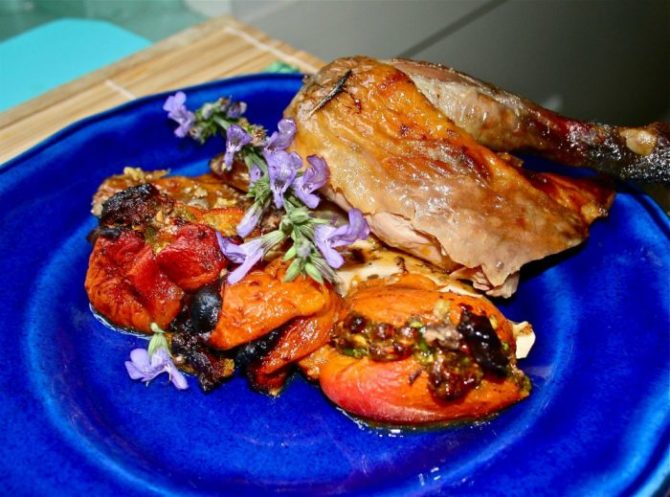The Apricot and French Cuisine

Apricots have just entered the market for the year, their brushed orange and red skins like a soft, tender cheek to plant a kiss upon. The apricot has an allure that is hard to define, for it’s self-contained, keeping its true self hidden from view. Its skin is beautiful –ranging from a pale orange to an almost angry, red-tinged sunset hue – but unlike a peach or nectarine, the apricot emits little perfume.
The truly wonderful aspect of the apricot is its soft flesh, which drips with intensely sweet, slightly thick juice and tastes like a cross between the finest honey and a wild, sun-kissed berry. What might otherwise be a heavy, filling fruit is kept light and precious by a pleasing touch of acidity. Apricots’ short season makes them doubly attractive – they arrive in June and are but a fleeting memory by late August.
Well-Travelled
That apricots have a wild flavour is no surprise as they originate from China, growing wild until some 2,000 years ago, when their cultivation is first documented. From China, the apricot travelled along the spice route, making its way to Armenia, Turkey and other points in the Orient. Because the fruit flourished in Armenia, it was thought to have originated there and it is said that the Romans who gave the apricot its name, Prunus armeniaca. The Saracens introduced the apricot to Spain and the Mediterranean in the 7th Century, yet its cultivation only began in France during the 15th Century, in the gardens at Versailles, under the watchful eye of Louis XIV.
Although Versailles may have been the apricot’s first official French home, it really thrives in warmer temperatures. Today, it’s grown from the Pyrénées Orientales, through Languedoc-Roussillon and Provence, then up into the Rhône Valley. It tolerates cold nights, but needs high daytime temperatures to burnish its skin and ripen its juicy flesh.
Short Season
There are more than 200 varieties of apricots currently being studied by French fruit researchers, for it’s now the third most cultivated fruit in the country. They’re looking not only to develop new varieties, but also to extend the apricot’s short growing season.
The French are always so good at offering produce at the height of its season, but trip up a bit with the apricot, through sheer impatience. This is easy to understand, as France has two very bleak food months, from mid-March to mid-April, when apples and pears have lost their vigour, to be replaced by tasteless imports. This time of the year is too soon for really good strawberries, cherries are still a half-season away and France’s citizens are champing at the bit for something fresh and beautiful to eat, which will reassure them that summer is indeed on the way. Producers oblige, but the first, pale-orange apricots to show up in the market place, sometimes as early as mid-May, are as hard as little rocks, boast high acidity and should be avoided. Sadly, apricots don’t ripen once off the tree so these early arrivals will develop sugars and change texture, but remain hard and uninteresting.
According to Bruno Loquet, engineer at the Centre Technique Interprofessionel des Fruits et Légumes in the Gard region, the trick to ensuring excellent apricots is harvesting at the perfect moment. Not the moment when they’re most ripe, but that satisfies all commercial criteria. Growers judge this moment by the colour of the apricot – its background must no longer be green, but an even orange-to-red.
Then, the apricots can be handled and shipped with ease, and will evolve into fruit that is pleasing to the consumer. If apricots are harvested too soon – as is the case with those early season ‘rocks’ – it won’t evolve.
How can you tell when an apricot is at its peak? There’s no sense in talking in terms of ripeness, unless you have your own tree. Instead, we’ll talk evolution, and it’s all in the eye. An ideal apricot takes on a certain luminescence, as though lit from within.
A really good apricot won’t bruise if you touch it, but it should give a little when lightly squeezed. Depending on the variety, as noted, the skin should be a vivid orange-to-red colour. Oddly, perhaps because the skin of an apricot is very slightly furry, it may feel almost warm.
Culinary Patience
Once you have determined the evolutionary state of the apricot, what you plan to do with it enters the picture. If you want to eat it naked, softer and redder is best, and the same goes if you’re going to make jam or compote. For a tart, or any other use where you’d like the apricot to maintain some shape, slightly under-evolved is best. The apricot will be a bit more acidic at this stage, though it will have plenty of flavour.
So once you’ve got your apricots, what will you do with them? Well, you have to make apricot jam, and when you do, save a pit for every jar. Inside of an apricot is a rock-hard pit which envelopes a bitter almond. Crack the pit – using a hammer, not a nutcracker – and put a bitter almond in each jar of jam to lightly scent it with a haunting, alluring almond flavour that will elevate it well above the ordinary.
If you’re going to make a tart, choose the prettiest, most reddish orange apricots you can. Or for stuffed apricots, to roast with fowl, fish or meat, pick a firm specimen that won’t disintegrate during the cooking process. Should you feel adventuresome, I recommend the recipe on the right – use slightly firm apricots.
Above all, when it comes to the apricot, patience is the operative word. Use your patience and the rewards are rich and satisfying: a luxurious, honeyed flavour and a sensuous juice that is like nothing else.
ROAST GUINEA HEN WITH STUFFED APRICOTS
PINTADE AUX ABRICOTS FARCIS
SERVES 4-6
ONE WHOLE FARM-RAISED GUINEA HEN (3-4 POUNDS, 1.5-2KG) AT ROOM TEMPERATURE, GIBLETS REMOVED BUT RESERVED
FINE SEA SALT AND FRESHLY GROUND BLACK PEPPER
1 LEMON, CUT IN HALF
SEVERAL BAY LEAVES
1?4 TEASPOON GROUND CARDAMOM
1 TABLESPOON UNSALTED BUTTER, SOFTENED
FOR THE APRICOTS:
12 APRICOTS
1 CLOVE GARLIC, PEELED
1/3 CUP PISTACHIOS, SALTED
1 LARGE EGG YOLK
1 SCANT TABLESPOON MILD HONEY
1?4 TEASPOON GROUND CARDAMOM
FINE SEA SALT
2 TABLESPOONS (30G) UNSALTED BUTTER, CHILLED, CUT INTO 12 EQUALLY-SIZED PIECES
- PREHEAT THE OVEN TO 450 DEGREES F (230 DEGREES C).
- SEASON THE CAVITY OF THE GUINEA HEN WITH SALT AND PEPPER, THEN STUFF IT WITH THE LEMON, THE BAY LEAVES AND THE GIBLETS.
- BLEND THE GROUND CARDAMOM WITH THE BUTTER. LOOSEN THE SKIN FROM THE BREAST MEAT OF THE GUINEA HEN. REACHING CAREFULLY UNDER THE SKIN, RUB THE MEAT WITH THE BUTTER MIXTURE. TRUSS THE GUINEA HEN.
- PLACE THE GUINEA HEN IN A ROASTING PAN AND POUR 1 CUP OF WATER AROUND IT. ROAST FOR 45 MINUTES, CHECKING ONCE TO BE SURE THERE’S LIQUID IN THE BOTTOM OF THE PAN. IF NECESSARY, ADD MORE WATER, TO KEEP AT LEAST 1?4-INCH OF LIQUID IN THE PAN.
- WHILE THE GUINEA HEN IS ROASTING, MAKE A SHORT SLICE IN EACH OF THE APRICOTS AND REMOVE THEIR PITS, LEAVING THE FRUIT AS INTACT AS IS POSSIBLE. RESERVE THE PITS.
- CRUSH THE GARLIC IN A MORTAR AND PESTLE WITH A LARGE PINCH OF SALT. ADD THE PISTACHIOS AND CONTINUE CRUSHING UNTIL THEY’RE NEARLY MINCED. STIR IN THE EGG YOLK, HONEY, CARDAMOM AND A PINCH OF SALT. DIVIDE THE MIXTURE AMONG THE APRICOTS, STUFFING IT INTO THE SPACE LEFT BY EACH PIT. PLACE THE APRICOTS AROUND THE GUINEA HEN, WITH THE ‘CUT’ POINTING UPWARDS, ALONG WITH THE RESERVED PITS. ADD WATER AROUND THE GUINEA HEN SO THE PAN ISN’T DRY. ROAST FOR 15 MINUTES.
- WHEN THE GUINEA HEN IS ROASTED – TO TEST FOR DONENESS, PIERCE THE THIGH JOINT WITH A SHARP KNIFE AND THE JUICES SHOULD RUN CLEAR – TRANSFER IT TO A CUTTING BOARD WITH A TROUGH AROUND IT, TO CATCH THE JUICES. SPRINKLE THE GUINEA HEN ALL OVER WITH SALT, THEN TURN IT ON ITS BREAST SO THAT THE JUICES RUN INTO THE MEAT, AND LET IT REST.
- DOT THE APRICOTS WITH THE CHILLED PIECES OF UNSALTED BUTTER, PUSHING THE BUTTER DOWN INTO THE SOFTENED FLESH OF THE FRUIT, AND RETURN THEM TO THE OVEN TO ROAST UNTIL THE APRICOTS ARE SOFTENED AND GOLDEN, THIS SHOULD TAKE 10 TO 15 MINUTES. WHEN DONE, DISCARD THE APRICOT PITS.
- TO SERVE, CUT THE GUINEA HEN INTO SERVING PIECES. REMOVE THE GIBLETS, LEMON AND THE BAY LEAVES FROM THE CAVITY. DISCARD THE BAY LEAVES. PLACE THE GUINEA HEN AND GIBLETS ON THE PLATTER AND SQUEEZE OVER THE LEMON. ARRANGE THE STUFFED APRICOTS AROUND THE GUINEA HEN AND SERVE.
Susan Herrmann Loomis teaches cooking classes in Normandy and Paris. Find her cookbooks online in the France Today bookstore.
Originally published in the August-September 2013 issue of France Today
Share to: Facebook Twitter LinkedIn Email
Leave a reply
Your email address will not be published. Required fields are marked *



